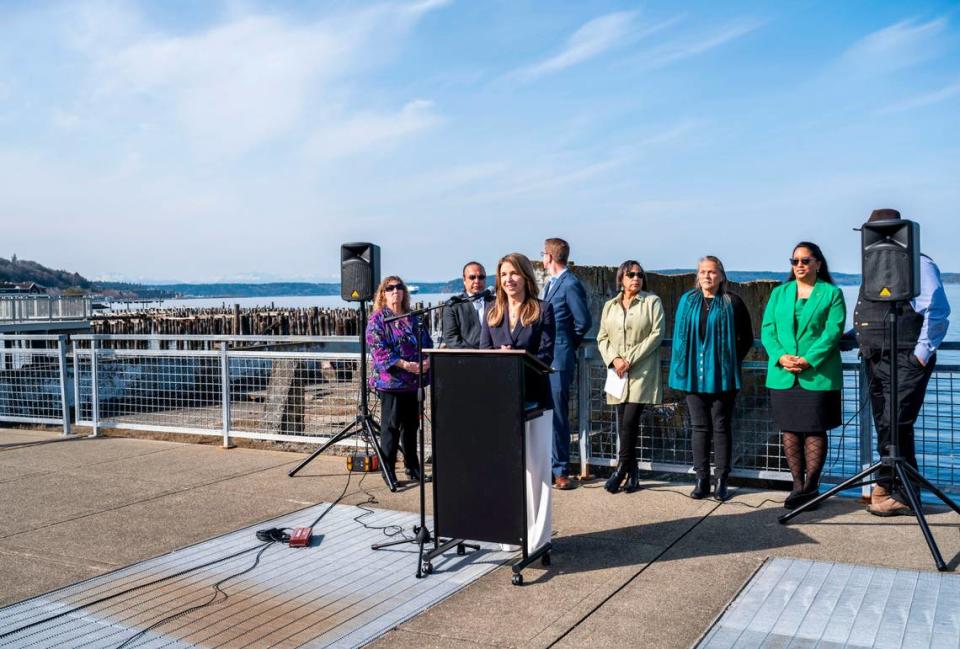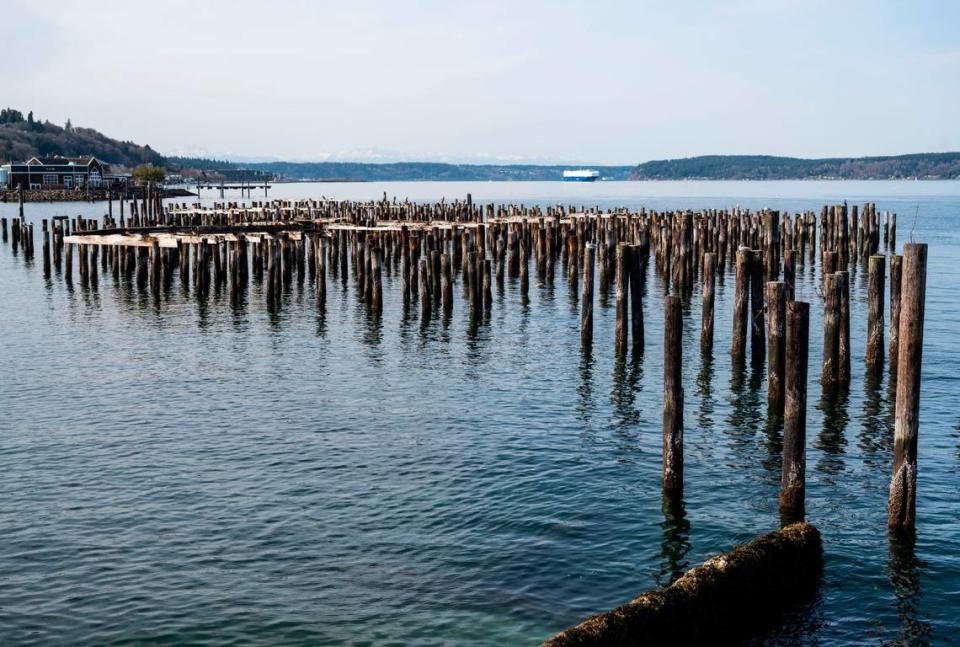‘Filthy Four’ — state targets Tacoma site with 1,200 polluted pilings for cleanup
Walkers along Tacoma’s Ruston Way and sunbathers at Titlow Beach have seen them for decades: pilings — the aquatic cousins of telephone poles. Once used to support wharves and piers, many of the abandoned logs are infused with the wood preservative creosote.
Creosote is now banned for aquatic use — and for good reason, say those who study the chemical and how it adversely affects marine organisms.
Until now, the state has been slow to remove abandoned and polluted pilings due to lack of funding and authority. But that could all change if a bill making its way through the state Legislature is passed and signed by Gov. Jay Inslee. It authorizes a new program to accelerate the Department of Natural Resources’ (DNR) clean-up programs with $21 million in funding for six years.
On Friday, state Commissioner of Public Lands Hilary Franz and other dignitaries gathered at Dickman Mill Park on Ruston Way to announce support for two companion bills making their way through the Legislature that remove abandoned, human-made structures in state aquatic lands and restore habitat.
“These pilings need to be removed as soon as possible,” Franz said. “So we can actually restore this area to healthy waterways and healthy salmon habitat.”
The state already has an aquatic resources restoration program primarily focused on Puget Sound but the new bill will boost the budget and expand the program to places like Neah Bay and the lower Columbia River.
The newly reinvigorated Tacoma park is built on the site of the Dickman Mill — one of Tacoma’s pioneer sawmills. The mill operated from the 1890s to 1979 when it was significantly damaged in a fire.
Today, as many as 1,200 pilings poke out of the water or stand at attention just beneath the surface. At low tide the collection resembles a beard in need of a close shave. It’s unknown how deep the pilings go into the sediment, said Thomas Gorman, DNR’s Aquatic Resources Division manager.
The mill is one of the so-called “Filthy Four” that DNR has put on top of their clean-up to do list. The other three are Ray’s Boathouse pier in Seattle, the Triton-America pier in Anacortes and the High Tides Seafood pier in Neah Bay on the Makah reservation.
Types of structures
It’s just not pilings the new program is going after. It also includes tire reefs, abandoned recreational docks, derelict boats and in the case of the Dickman Mill, wood debris.
During its operation, the mill cast sawdust and chunks of wood into the water which, in some cases, sank to the bay floor rather than floating away. That waste can form a barrier to aquatic life, Gorman said.
But it’s the pilings that are both the most noticeable and most polluting, he said. In 2009, DNR conducted a Puget Sound wide survey of all pilings, both derelict and in use, on state-owned aquatic lands. Since then, some 60 percent of those have been removed, but approximately 13,000 pilings remain.
Puyallup tribal vice-chairwoman Sylvia Miller said Friday that the clean-up is long overdue and that a restoration of sea life habitat benefits everyone.
“Because that habitat that we always took for granted that would be here for us is not here for any of us anymore,” Miller said. “These are the foods that don’t only feed the poor people, they feed all of us.”
Creosote
Used since the 1800s to preserve wood, wood-tar creosote is one of several types of the chemical compound which can be made commercially or produced naturally when wood is burned in a fireplace.
The green-hued coal-tar creosote is an effective wood preservative but it comes with dangers. It’s considered carcinogenic to people and harmful to aquatic life.
Studies have shown that the eggs Herring and other fish lay on creosote-infused structures can fail to develop, Gorman said.
Makah tribal chairman T.J. Greene said the abandoned pier in Neah Bay sits directly over shellfish beds. Removing it enables a healthier future for his tribe, he said.
“The health of our children and elders to be able to access traditional foods without the worry of of ingesting something that’s going to harm them detrimentally long term,” he said.
New program
About $11 million will be spent on the “Filthy Four”, Gorman said, with $3.5 to $4 million spent at Dickman Mill alone.
Until now, there just hasn’t been enough funding to tackle large projects. A partially sunken boat, Hero, sat in the tidal waters of pristine Willapa Bay for years before it was recently removed.
“The trouble we’ve had is that with a smaller amount of funding, we can’t do these larger projects,” Gorman said.
The funding of the derelict vessel removal account is now stable, which allows DNR to plan for and respond quickly to future shipwrecks and removals, he said.
Habitat restoration
Whether its shipwreck or piling removal, habitat restoration is usually soon to follow.
In some cases, ships and pilings act as an underwater soil barrier. Gorman said studies are being conducted at the Dickman Mill site to see how removing the pilings will affect nearby habitat.
“When you remove them, is it going to create a erosion on any of the neighboring properties?,” Gorman said. “We want to make sure that does not happen.”
Some of that soil could be contaminated with creosote leached from the wooden pilings over decades.
“The main thing is to try and as quickly as we can, if we get the funding, to remove the remaining pilings to at least stop the leaching of the creosote,” he said.
The Bills
House bill 1378 and its companion, Senate bill 5433, are scheduled for hearings soon. They have bipartisan support, several speakers at Friday’s event said.
“What we have done over the last couple of months is very much a bipartisan effort,” State Sen. Ron Muzzall (R-Oak Harbor) said.
“We find ourselves in a time where hyper partisanship seems to be the norm,” said State Rep. Kristine Reeves (D-Federal Way). “And I can tell you that the one thing we can all agree on in this legislation is the importance of protecting our environment.”
If all goes smoothly, Dickman Mill’s pilings could be gone within five years, Gorman said. One major hurdle is just finding contractors to bid on the jobs.
The future
One group that wasn’t present at Friday’s event were the businesses and industries that created the pollution in the first place. Many, like Dickman Mill, are long gone. Some, like derelict boat owners, don’t have the funds to clean up the messes they’ve left behind.
Franz said all current leases on state aquatic lands now require tenants to remove infrastructure they’ve installed.
On Friday, the only tenants occupying Dickman Mill’s pilings were hundreds of seagulls basking in the spring-like weather.



